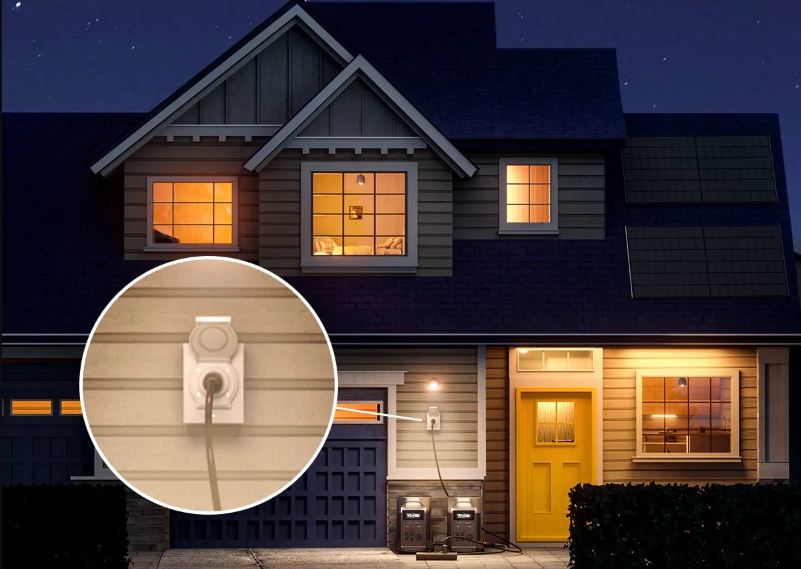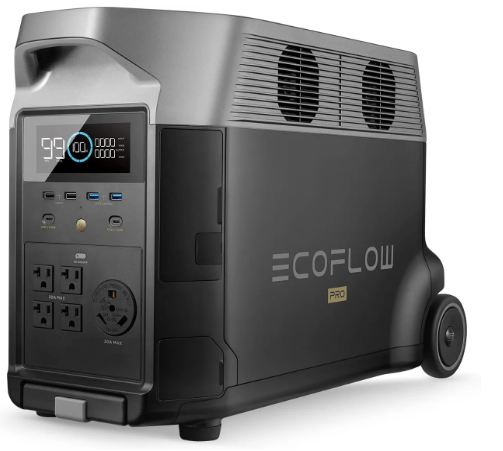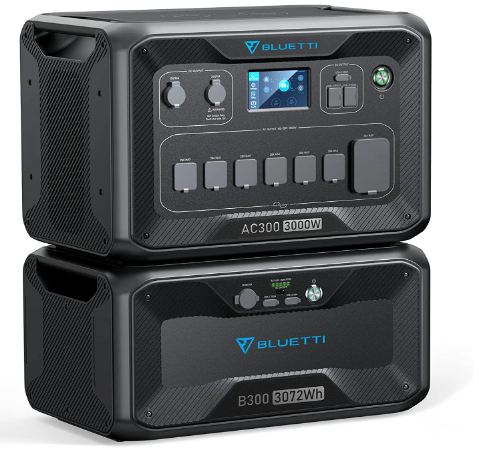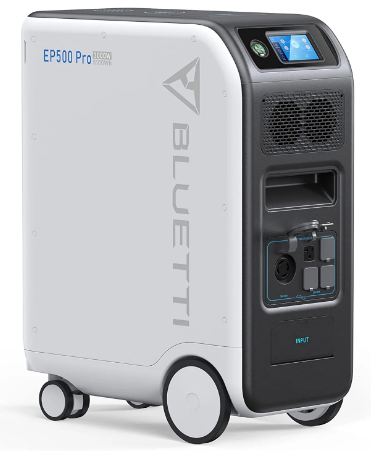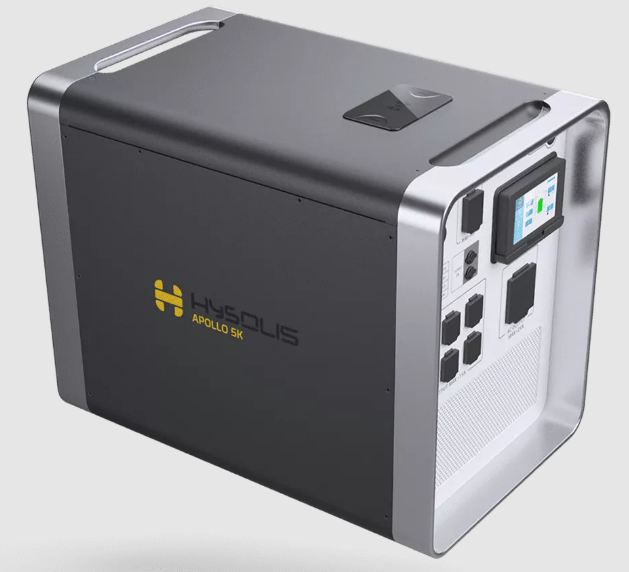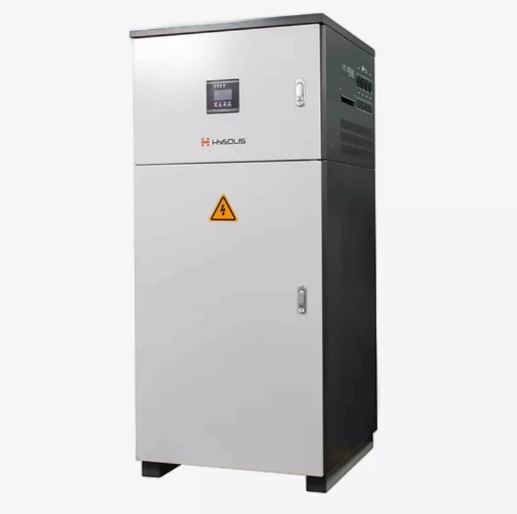Shopping for a 240V solar generator?
You’ve come to the right place.
The majority of solar generators sold in the United States and Canada produce 110V/120V AC power since most household appliances run on 120V power. However, some large appliances need more power. They run better and more efficiently with higher voltage.
Examples include clothes dryers, cooking ranges, water heater, well pumps, and central air conditioners. Many of these run on 240V AC power.
You’ll need a matching 240V solar generator if you want to power one of these appliances off-grid or during a power outage.
What’s In This Guide?
In this guide, I review the best 240V solar generators in the market.
Because 240V solar generators are highly uncommon in the US, most of my picks are dual solar generator kits where you have two power stations that work together to produce 240V AC power. I explain more about this below.
If you are looking for regular 120V solar generators, see my best picks for home backup.
What Is 240V Split Phase Power?
All our top picks, except the Hysolis SPS6K, need to be connected to a second similar unit to deliver 240V AC power. Once you decide which one is best for you, you’ll need to order two of them plus a special connector to get 240V power.
Manufacturers refer to this as split phase 240V power. What does that mean?
In North American homes, mains power is distributed via a 3-wire split phase system. There are two live wires (each carrying 120V) and a neutral wire.
Regular 120V outlets are wired with one of the two wires plus the neutral wire. That’s enough power for most household appliances.
You may also have high-power outlets or appliances such as ovens and dryers wired with 240V power. These outlets and appliances are connected to both live wires and the neutral wire, allowing them to run efficiently on 240V power.
Solar generators typically have a built-in single phase inverter that delivers only 120V power. It has just two wires (the live wire and a neutral wire), unlike the three wires in a home circuit.
That limits you only to powering 120V appliances.
But some manufacturers like Bluetti, EcoFlow and Hysolis have come up with a brilliant way of getting their solar generators to deliver 240V power.
By connecting two similar 120V solar generators, you create a split phase 240V power system roughly similar to the one in your home. The two inverters in the solar generators deliver double the voltage and double the power. So you can now power 240V appliances.
By the way, if you are wondering why the Hysolis SPS6K doesn't need to be connected to a second unit to deliver 240V power, it’s because it already has a built-in split phase inverter that can deliver 120V or 240V.
Best 240V Solar Generators
- 1Most Powerful: EcoFlow Delta Pro
- 2Most Versatile Outlets: Bluetti EP500 Pro
- 3Best Budget: Bluetti AC300 + 1*B300
- 4Most Expandable: Hysolis Apollo 5K
- 5Highest Capacity: Hysolis SPS6K
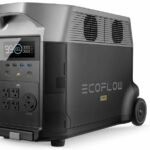
EcoFlow Delta Pro
Most powerful
3600Wh LiFePO4 battery
3600W single phase, 7200W dual phase output
Expandable:
Yes, to 25kWhMax solar input:
1600WWeight:
98.8lbsWarranty:
5 years
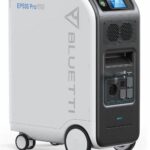
Bluetti EP500 Pro
Most versatile outlets
5100Wh LiFePO4 battery
3000W single phase, 6000W dual phase output
Expandable:
NoMax solar input:
2400WWeight:
182lbsWarranty:
5 years
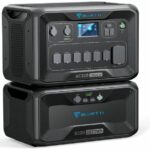
Bluetti AC300 + 1*B300
Best budget
3072Wh LiFePO4 battery
3000W single phase, 6000W dual phase output
Expandable:
Yes, to 12.2kWhMax solar input:
2400WWeight:
127.2lbsWarranty:
4 years
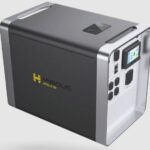
Hysolis Apollo 5K
Most expandable
5376Wh LiFePO4 battery
3000W single phase, 6000W dual phase output
Expandable:
Yes, to 48.4kWhMax solar input:
4000WWeight:
132lbsWarranty:
2 years for solar generator, 3 years for battery
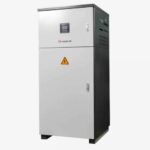
Hysolis Apollo SPS6K
Highest capacity
19200Wh Lead-acid gel batteries
3000W single phase, 6000W dual phase output
Expandable:
YesMax solar input:
5400WWeight:
1298lbsWarranty:
years for solar generator, 3 years for batteries
1. Most Powerful 240V Solar Generator: EcoFlow Delta Pro
If you are shopping for a 240V solar generator that produces lots of power, I recommend the EcoFlow Delta Pro. Its 3600W inverter makes it the most powerful solar generator among our top picks.
It’s ideal if you want to power multiple larger appliances or a big portion of your home.
Pros
Cons
Our Review
The EcoFlow Delta Pro is one of our favorite high-capacity, high-output portable solar generators. It’s a great pick for anyone shopping for a home backup or off-grid solar generator.
The Delta Pro packs a 3600Wh LiFePO4 battery with a lifespan of over 6500 cycles. A built-in single phase inverter delivers up to 3600W of 120V AC power.
The Delta Pro has 15 outlets including 5 120V AC outlets, 3 12V DC ports, a 30A Anderson output, 2 100W USB-C ports and 4 USB-A ports.
Setting up Split Phase Power
To get 240V split phase power, you’ll need to buy a second EcoFlow Delta Pro and the EcoFlow Double Voltage Hub.
Connect the two solar generators with the double voltage hub to get up to 7200W, 240V AC power.
The hub comes with three outlets: two NEMA 6-20 outlets to plug in heavy appliances (up to 20 amps) and one NEMA L14-30 outlet that you can use to connect the two solar generators directly to your home or RV.
A few things to note:
What Can The Delta Pro 240V Kit Power?
The split phase Delta Pro kit can power any 200-240V appliance that uses less than 7200W (7.2kW). If you are running multiple appliances, make sure the total load is under 7200W and 20A (for the 20A outlets) or 30A (for the 30A NEMA outlet).
Here are the approximate runtimes. Remember the total capacity also doubles to 7200Wh and you can expand this to 50kWh with additional Delta Pro batteries.
Appliance | Approximate runtime |
|---|---|
Electric oven (2800W) | 2.1hrs |
Space heater (2000W) | 3hrs |
Well pump (700W) | 8.7hrs |
Induction cooktop (2200W) | 2.7hrs |
HVAC (3000W) | 2hrs |
Charging Options
The Delta Pro offers some of the most versatile charging options I’ve seen in a solar generator.
You can charge it from a wall outlet. EcoFlow X-Stream fast charging technology takes the Delta Pro from 0 to 80% in just 2.7 hours.
You can also charge the Delta Pro from EcoFlow’s smart dual fuel generator, a handy option when there’s a blackout or you are off-grid.
Solar charging is also great for emergencies and off-grid living. The Delta Pro accepts up to 1600W of solar input.
You can also charge the EcoFlow Delta Pro from any level 2 EV charging station, which will charge the battery in just 1.7 hours.
For even faster charging, you can combine AC, solar and the EcoFlow smart generator to put in up to 6500W of power.
These fast charging speeds will come in handy when you decide to expand your solar generator. You can add more batteries while still charging everything in just a few hours.
Note: Even with the double voltage hub connected, you still need to charge each solar generator separately. The voltage hub doesn't charge the solar generators.
Issues & Limitations
The 1600W solar input of the EcoFlow Delta Pro may seem high, but it’s actually the lowest among our top picks.
That means the Delta Pro has the slowest solar charging speed, a concern if you are setting up an off-grid system.
2. Most Versatile Outlets: Bluetti EP500 Pro
Shopping for a 240V solar generator with lots of different outlets? Get the Bluetti EP500 Pro.
It has 17 outlets, including a couple of wireless charging pads.
Pros
Cons
Our Review
The Bluetti EP500Pro comes with a massive 5100Wh LiFePO4 battery that lasts over 3500 cycles to 80% capacity.
Continuous power output from the pure sine wave inverter is 3000W. You can access the AC power via four 110V AC outlets and one NEMA L14-30 outlet.
For devices and gadgets, you get two USB-C PD 100W port, four USB-A ports and two 15W wireless charging pads.
And for your 12V electronics, there are three 12V DC ports. For RV owners, there’s a 12V/30A RV port.
Split Phase Power
Setting up the EP500 Pro to deliver 240V split phase power is pretty straightforward. You’ll need a second EP500 Pro plus the P030A fusion box.
Use the communication ports and the NEMA L14-30 outlets to connect the two solar generators. All the cables you need are included with the fusion box.
You’ll need to change a few things in the settings to get started with split phase power. Check the manual for specific instructions.
Once you set up everything correctly, you can draw up to 6000W 240V AC power from the NEMA L14-30 outlet on the fusion box. Either plug in 240V appliances into the outlet or use it to connect the fusion box to your home grid to supply 240V power to some circuits in your home.
The fusion box also includes two 120V/30A RV ports and four regular 120V outlets.
Here are a couple things to note when setting up the EP500 Pro in split phase mode.
What Can The Bluetti EP500 Pro 240V Kit Power?
Here’s how long you can expect to run various 240V appliances off the two EP500 Pro solar generators (10,200Wh total capacity).
Appliance | Approximate runtime |
|---|---|
Electric oven (2800W) | 3hrs |
Space heater (2000W) | 4.3hrs |
Well pump (700W) | 12.3hrs |
Induction cooktop (2200W) | 3.9hrs |
HVAC (3000W) | 2.9hrs |
Charging Options
Each solar generator accepts up to 3000W from a wall outlet. This charges the battery in 3.3 hours.
Solar charging is also pretty fast. The EP500 Pro accepts up to 2400W of solar power, which charges the battery in 2.7 hours.
You can combine solar and AC charging to recharge one EP500 Pro in just 1.8 hours.
Issues & Limitations
One of the biggest limitations of the Bluetti EP500 Pro is that you cannot expand its capacity. You are limited to the 10.2kWh combined capacity of the two solar generators.
If you think you’ll need more capacity in the future, pick a different solar generator.
The other issue is that you only get one 240V outlet. If you want to run more than one 240V appliance, you’ll have to set up a breaker panel and wire the fusion box to it. That means spending extra money on an electrician.
3. Best Budget 240V Solar Generator: Bluetti AC300 + 1*B300
240V solar generators tend to be pricey, and the Bluetti AC300 + B300 kit is no different. It costs more than most portable solar generators.
But it’s one of the most affordable 240V power stations. If you are shopping on a budget, I recommend the AC300 + B300 solar generator kit.
Pros
Cons
Our Review
Bluetti sells the AC300 and B300 as a combo. The AC300 is just the power module with the inverter, MPPT charge controller plus the inlets and outlets. The B300 is the battery (LiFePO4).
We’ve seen this modular design in other brands like Inergy and Titan. It’s great because it lets you easily add or remove batteries from your setup. And when the battery dies, you simply buy a new one instead of replacing the entire solar generator.
The B300 has a capacity of 3072Wh. You can add up to three more B300s for a total capacity of 12288Wh.
The AC300 has a 3000W inverter with a peak output of 6000W. The inverter delivers power to six 20A 120V AC outlets and a 30A port.
There are two DC outlets: a 12V/30A RV port and a 24V/10A car outlet. For devices and gadgets, you get a 100W USB-C port, four USB-A ports and two 15W wireless charging pads.
Split Phase Power
To set up 240V split phase power, you’ll need the same P030A fusion box the Bluetti EP500 Pro uses. You’ll also need a second set of the AC300 power module and the B300 battery pack.
Setting up the AC300 to deliver 240V power is pretty much the same process as the EP5000 Pro.
You use the included communication cable to link the two kits, then you connect the two 30A AC output ports.
Now you should get up to 6000W 240V power on the 30A outlet on the fusion box. Capacity also doubles to 6144Wh.
Maximum possible capacity is 12288Wh for each kit. So you can have a total capacity of 24576Wh or 24.5kWh.
Just remember to keep the system balanced. If you add a B300 battery pack to one side, also add one to the other side.
You can charge each kit separately after disconnecting the fusion box, but it’s easier to get the 30A split fusion AC charger. It will charge both at the same time and you don't have to disconnect the fusion box.
What Can The AC300 + B300 240V Kit Power?
Here are the approximate run times you’ll get from the 6000W, 240V, 6144Wh AC300 + B300 kit.
Appliance | Approximate runtime |
|---|---|
Electric oven (2800W) | 1.8hrs |
Space heater (2000W) | 2.6hrs |
Well pump (700W) | 7.4hrs |
Induction cooktop (2200W) | 2.3hrs |
HVAC (3000W) | 1.7hrs |
Charging Performance
Like the EP500 Pro, the AC300 + B300 kit charges pretty fast.
The included AC charger puts in up to 3000W, charging the B300 in 2.2-2.7 hours. Max solar input is 2400W which takes 1.8-2.3 hours to recharge the B300.
You can also combine AC + solar to get an input of up to 5400W and a speedy charging time of just 1.5 hours.
Even when you expand your system later with additional B300 batteries, you are assured of fairly fast charging.
Issues & Limitations
If you want a 240V solar generator kit that you can add lots of batteries to, the AC300 + B300 kit may not be the right choice. You are limited to 12.2kWh for one kit and 24.5kWh for both.
It’s certainly better than the EP500 Pro which is not expandable at all, but there are better alternatives. The EcoFlow Delta Pro kit is expandable to 50kWh total and the Hysolis Apollo 5K is expandable to a whooping 435.6kWh.
The other issue is that you only get one 240V outlet on the fusion box. This is a problem if you want to power multiple 240V appliances without setting up a breaker panel.
4. Most Expandable 240V Solar Generator: Hysolis Apollo 5K
The Hysolis Apollo 5K is hands down the most expandable 240V solar generator you’ll find. Probably no one needs close to 500kWh in capacity, but you can expand the Apollo 5K to 435.6kWh if you want.
Not only that, you can also expand its output to a whooping 27kW, which is probably enough to run a small factory.
If you want a 240V solar generator with highly expandable capacity and power output, I recommend the Hysolis Apollo 5K.
Pros
Cons
Our Review
More and more companies have been launching expandable solar generators - Bluetti, EcoFlow Titan, Inergy and so on.
But I have yet to see any that is as expandable as the Hysolis Apollo 5K.
Let’s start with the capacity. The Apollo 5K comes with a 5376Wh LiFePO4 battery, which is removable by the way.
You can add up to 8 more batteries for a total capacity of 48.4kWh.
When you set up the 240V split phase system with two Apollo 5K solar generators, total possible capacity is 96.8kWh.
Hysolis says you don't have to stop at two. You can link up to nine stacks of Apollo 5K kits, each with a capacity of 48.4kWh. If you wanted, you could build a 435.6kWh system using just solar generators.
As power output, the Apollo 5K comes with a 3000W high efficiency inverter. They claim an impressive efficiency of 94%, though reviewers and experts are yet to test this in real life.
Expand to a split phase system and you can increase this to 6000W. With 9 Apollo 5K solar generators connected, you can get up to 27kW of pure sine wave AC power with a surge of 54kW.
I’ve often said that solar generators cannot power an entire home. That’s no longer true. The Apollo 5K can power a large home easy-peasy.
It even comes with a built-in UPS function that takes over in case of a blackout in under 15ms.
If you prefer connecting appliances and devices to it directly, it has six 120V/15A outlets, a 120V/30A outlet, a 12V/30A RV port, three 12V DC ports, four USB ports (including USB-C) and a wireless charging pad.
A removable wireless tablet lets you control the solar generator from up to 60 feet away. Or you can use a phone app.
Split Phase System
You’ll need at least two Apollo 5K solar generators to get 6000W 240V AC power. You can wire this directly to your home and run 240V appliances from outlets, or plug appliances directly into the solar generator kit.
What Can The Apollo 5K 240V Kit Power?
Here are the approximate run times for various 240V appliances connected to two Apollo 5K solar generators (10752Wh).
Appliance | Approximate runtime |
|---|---|
Electric oven (2800W) | 3.2hrs |
Space heater (2000W) | 4.5hrs |
Well pump (700W) | 13hrs |
Induction cooktop (2200W) | 4.1hrs |
HVAC (3000W) | 3hrs |
Charging Options & Speed
The Hysolis Apollo 5K is one of the fastest charging solar generators.
The included AC charger puts in up to 3000W of power, which charges the battery in about 110 minutes. Max solar power input is 4000W, enough to charge the Apollo 5K in 90 minutes.
There’s also a dual solar + AC charging option that recharges the Apollo 5K in 70 minutes.
So even when you add more batteries, you can still charge all of them fairly quickly.
Issues & Limitations
The only issue I have with the Hysolis Apollo 5K is the warranty. Considering its size and price, I’d expect a minimum 5 year warranty like what Bluetti and EcoFlow offer for their systems.
Instead, Hysolis offers a 2 year warranty on the power module and a 3 year warranty on the batteries. Not bad, but could be longer.
5. Highest Capacity 240V Solar Generator: Hysolis SPS6K
If you want a high-capacity solar generator without connecting lots of extra batteries, get the Hysolis SPS6K solar generator.
It comes ready with a capacity of 19.2kWh, which is plenty enough for most homes.
Pros
Cons
Our Review
The Hysolis SPS6K resembles a cabinet, a 1200+ pound cabinet. It’s a massive solar generator with eight 200Ah lead-acid gel batteries integrated into it.
The total capacity is 19200Wh, enough to back up your home for days or power an off-grid home.
When it comes to expanding capacity, Hysolis says you can attach any matching battery. I assume that means you can connect even a lithium battery as long as its voltage matches the other batteries.
Hysolis doesn't say whether there’s a maximum capacity.
If you don't think 19.2kWh is enough for you, contact Hysolis for guidance before adding extra batteries.
Split Phase Inverter
The Hysolis SPS6K is unique from other 240V solar generator in that you don't have to pair it with a similar unit to get split phase power.
It comes with a built-in split phase inverter. That means you can switch from 120V 3000W output to 240V 6000W output anytime you want.
There are four 120V outlets, four 240V NEMA L6-30R outlets and a 240V/120V 25A hardwired AC output.
You can integrate the Hysolis SPS6K into your home grid and use it as a UPS. When there is a blackout, it has a super quick takeover time of less than 10ms.
What Can The Hysolis SPS6K Power?
Here’s approximately how long you can power different 240V appliances using the Hysolis SPS6K. Note that I use half the capacity (9600Wh) since a 50% depth of discharge is recommended for lead-acid gel batteries.
Also, these runtimes don't take into account inverter efficiency. In real life, you’ll get slightly shorter runtimes.
Appliance | Approximate runtime |
|---|---|
Electric oven (2800W) | 3.4hrs |
Space heater (2000W) | 4.8hrs |
Well pump (700W) | 13.7hrs |
Induction cooktop (2200W) | 4.3hrs |
HVAC (3000W) | 3.2hrs |
Charging Options & Speed
The fastest way to recharge the Hysolis SPS6K is via the hardwired 240V/35A AC input. You can also use the included AC charger, but that charges at max 1200W, which is slow.
Solar charging is fast. Max input from solar panels is 5400W, the highest of any 240V solar generator in this guide.
Hysolis says you can also charge the SPS6K from a wind turbine.
Issues & Limitations
The Hysolis SPS6K is pricey, which is not a surprise given its massive capacity. If you are shopping on a tighter budget, consider one of the other picks I have reviewed. You can then add more capacity slowly over time.
The other thing I don't like about the SPS6K is that it uses lead-acid gel batteries. These batteries actually help keep the price of the solar generator relatively low, but they don't last long.
If you plan to use the solar generator regularly or daily, I highly recommend a lithium iron phosphate solar generator kit instead like the Hysolis Apollo 5K.
LiFePO4 batteries are expensive but they last for years and years (over 6500 cycles) with daily use.
But if you plan to use the solar generator only during emergencies, the Hysolis SPS6K is fine. The gel batteries can last for 10 years or more with occasional use. Just make sure you follow the maintenance instructions in the manual.
Why Buy A 240V Solar Generator?
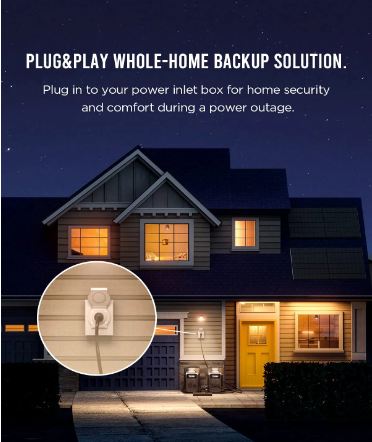
A majority of appliances in American households run on 120V power. But a few need a lot more power to run efficiently.
Things like dryers, washers, HVAC systems and water heaters are often connected to 240V outlets or hardwired to 240V circuits.
These appliances run more efficiently on 240V power. They use thinner (so, less expensive) wires and there’s less energy loss.
You could buy a 120V well pump and it will work fine. But a 240V pump will use cheaper cabling and will have more efficient energy use.
Big appliances also start more easily on 240V power. Motors in pumps and dryers running at 240V also tend to last longer.
Some appliances like ovens and heaters will actually put out less heat when connected to a 120V power source.
If you already have 240V appliances at home or in your RV or boat (e.g. a water heater, cooking range etc.), then it makes sense to get a 240V solar generator to power them.
A 240V solar generator is also ideal if you are planning to buy some 240V appliances. You can power these appliances off-grid or keep them running in case of an emergency.
What To Consider When Choosing A 240V Solar Generator
1. Ease of Set Up
As I explained at the beginning of this guide, getting 240V power from a solar generator requires some set up. But it should still be easy and straightforward.
If you have to hire an electrician or buy a gazillion additional parts, then look for another 240V solar generator.
At most, you only need an additional solar generator and a kit to link them. You should be able to easily plug in the right cables and have 240V power in a couple of minutes.
If you want it even easier, get the Hysolis SPS6K. It doesn't need any additional setup since it already has a 120V/240V inverter built-in.
2. Capacity, Type of Battery & Expandability
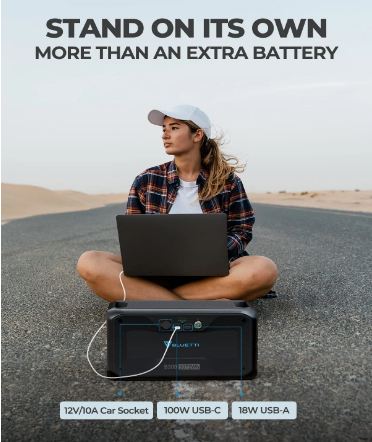
Next, check the capacity of the solar generator. The right capacity depends on your needs. If the solar generator is for your RV or you only need to back up a few appliances, a lower capacity (<5kWh) solar generator will do.
If you want to back up most or all of your house or power an off-grid home, get a 5+ kWh solar generator.
Remember that the capacity will double when you set up the split phase power system.
Also check whether you can add more capacity in the future and what the maximum capacity is. This is important if you think you’ll need more capacity later.
The other important factor to consider is the type of battery. When it comes to large home backup and off-grid solar generators, there’s only one battery chemistry we recommend - lithium iron phosphate or LiFePO4.
LiFePO4 batteries are stable, they charge quickly and they last an incredibly long time even with daily use.
They are heavy, but home backup solar generators are not designed to be portable anyway. They are also pricier than other types of batteries, but their longevity makes them worth it (and they are getting cheaper).
3. Output
The most common output for 240V solar generators is 3000W from a single solar generator and 6000W when you set up a split phase system.
6000W can power some heavy duty 240V appliances. If you think you need more power than this, get the Hysolis Apollo 5K. It’s the only 240V solar generator I’ve come across that lets you expand power output.
You can get up to 27kW by connecting nine Apollo 5K solar generators.
4. Outlets
Check the number and type of outlets the solar generator comes with.
The best 240V solar generators will have several AC, USB and DC outlets. Many also include high-power 30A AC outlets and 30A DC RV outlets.
Also check how many 240V outlets are available. If you only plan to power one 240V appliance like a well pump, then a single outlet is enough.
But if you have several 240V appliances, check that there are several matching 240V outlets.
5. Home Integration
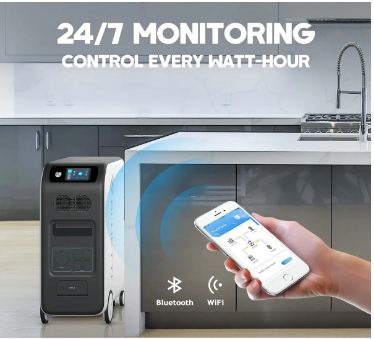
Virtually all 240V solar generators have the option of home integration. They’ll usually have a 30A 240V outlet that you can connect to a breaker panel and distribute 240V power to select circuits in your home.
If the solar generator has a UPS function, install an automatic transfer switch so that it switches over automatically to the solar generator when power goes out.
6. Charging Options & Performance
Finally, check what kind of charging options are available.
240V solar generators tend to be huge, so you need fast charging. Make sure the solar generator comes with a powerful AC charger that can put in 2000-3000W of power.
It should also have a high-input MPPT charge controller that accepts 2000W or more of solar power.
If you want even faster charging (under 2 hours), look for a 240V solar generator that allows simultaneous solar and AC charging.
Frequently Asked Questions
Can solar generators run 240V appliances?
Most solar generators produce 120V AC power, so they cannot run 240V appliances. But a few can be paired with a similar solar generator to produce 240V power. This is called a split phase system.
What can a 240V solar generator run?
240V solar generators can run 240V appliances like dryers, well pumps, ovens and heaters. Make sure the appliance doesn't pull more watts than the max inverter output.
What size solar generator do I need to run a 240V HVAC system?
Central air conditioners can use up to 4000-5000 watts of power. So a standard 6000W 240V split phase solar generator kit can power a residential HVAC system.
Can a 240V solar generator power an RV?
Most 240V solar generators can power an RV. In fact, most have a high-output 30A port designed to plug directly into RVs.
Keep in mind, however, that some appliances in your RV probably run on 120V power. Some outlets and circuits may also be rated for 120V power only.
You can work with an electrician to ensure that the 240V solar generator only powers 240V circuits and appliances. Alternatively, you can convert your RV into a full 240V power system.

